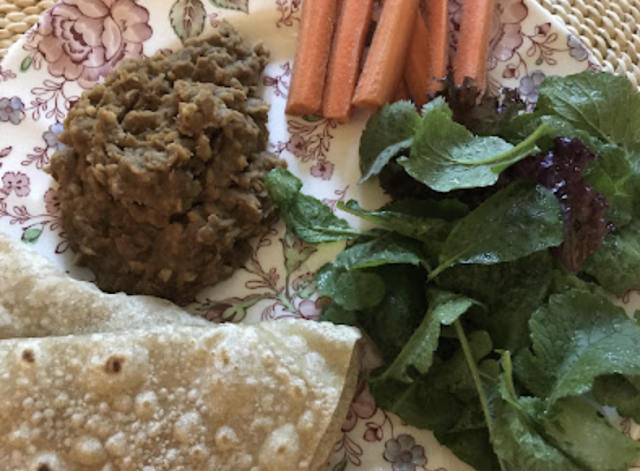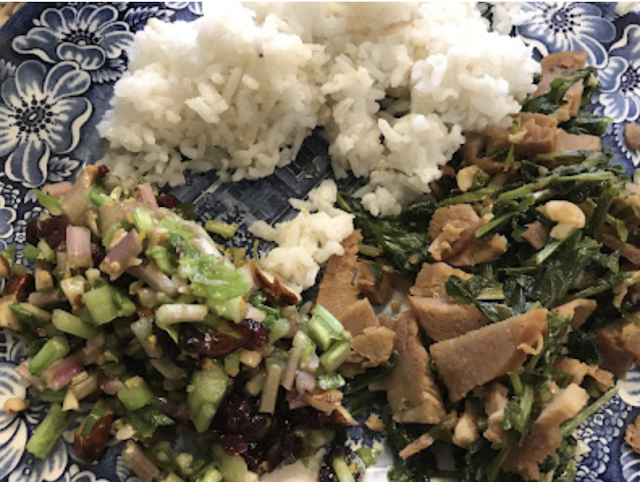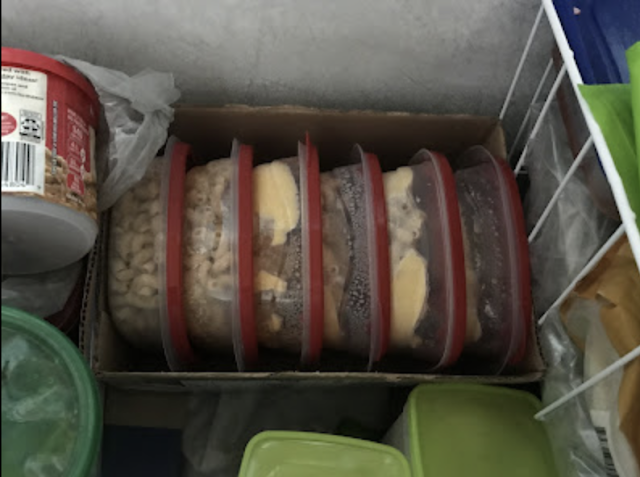 |
| Wednesday's supper -- my daughter and I collaborated. I harvested, she cooked. |
I didn't take very many photos of dinners this week, which of course made it very hard to remember what we had. I think I may have forgotten a couple of items. Oh well, this is the gist of what we ate this week.
Friday
garden green frittata, hash brown potatoes, sausage links, watermelon chunks, green salad, homemade pickles
Saturday
scratch refried beans, cheese, salsa and homemade flour tortillas, garden salad, garden strawberries
Sunday
sautéed turnip greens and ham, rhubarb sauce, biscuits, ice cream (a variety of leftover ice cream from the past 2 years discovered when cleaning the freezers)
Monday
barbecued chicken leg quarters, French bread, watermelon chunks, garden salad
Tuesday
rice/cheese/chicken skillet dinner, broccoli/cranberry/almond salad
Wednesday
greens and sausage frittata, French bread, garden salad, garden strawberries, rhubarb and blackberry crisp
 |
Dolmathes soup is something I invented last summer --
it's most of the ingredients for stuffed grape leaves in soup form,
with grape leaves shredded as the leafy green and ground beef added for protein. |
ThursdayDolmathes soup, scratch scones, garden salad, watermelon chunks
We've been chasing a family of raccoons out of the cherry tree on a daily basis. So on Thursday I decided to just pick as many pink to red cherries as I could get to with a ladder, then pit and dehydrate those cherries. If I tried to wait until the cherries ripened, there wouldn't be any cherries. The raccoons, blackbirds and squirrels would have eaten them all. Dehydrating the cherries intensifies the sweetness (which isn't fully developed in underripe cherries). So I'm good with that. With the dehydrator on, I also put in 2 trays of sage leaves and 3 trays of oregano to dry.
As you can see by our menus, we're using a lot of garden produce now. One day at lunch, I was cutting back the basil to promote bushier plants and made a batch of pesto with the cuttings, along with some radish leaves. Delicious on French bread!
I used the crockpot several times this week, making rosemary polenta, a couple of batches of overnight steel cut oats, and chicken stock. We're low on bread, so the crockpot has been a helper in making starches for the family.
I spent more time organizing a freezer this past week, the 3rd of 4 freezers. I found a bunch of almost empty containers of ice cream. Many of these were homemade ice cream, so they were in repurposed plastic containers -- easy to not know what was in them. I found chocolate-fudge brownie (homemade), funfetti vanilla (homemade), French vanilla (commercial), peppermint (homemade), blackberry cheesecake (homemade), vanilla (commercial), and 2 slices of ice cream cake, Not bad, huh? We had ice cream for dessert on Sunday, everyone choosing what they wanted. Hopefully we'll finish it all off this coming weekend so I can have my freezer shelf available again. I also gathered together all of the containers of homemade soup stock. I found ham, beef, and chicken stock in containers. I put them all together on the same shelf, hoping we'll begin to use it up. I have one more freezer to organize. I've kept this one fairly organized all along, so it shouldn't be too time-consuming. Mostly, I'd like to take note of exactly what's in this one. I still have some produce from last summer that we should use before stocking this season's fruits and vegetables and I may have more frozen eggs in this freezer, which would be good to know about now.
I started some more seeds this past week. I started radish seeds for the greens under lights indoors in milk jug "pots". And I potted spinach seeds, which I pre-sprouted in a baggie inside a damp paper towel set in a warm place. I have a spot in the garden that will be harvested in about 2-3 weeks and I wanted to have spinach ready to go in that spot. Pre-sprouting the seeds and getting started in pots will give me a jump start on fresh spinach to harvest in late August through early September. In addition to both of these greens, I picked up a packet of seeds for something I tried, unsuccessfully, 30 years ago -- lamb's lettuce also known as corn salad. It's a cool weather green that supposedly does well in my area in the cooler months of fall and into winter. I'll be digging the garlic early next month and will plant the lamb's lettuce in that spot to use throughout fall, if I can get it to grow.
In addition to the rhubarb-blackberry crisp I mentioned in the menu, I also baked a double batch of cranberry-orange scones. These were enjoyed by all. I found 1 container of orange zest in the freezer and 2 containers of candied orange peel. As you can imagine, I'll be thinking of ways to use these orange flavorings in baking.
That's about it for my meals this past week. What was on your menu? Are you using a crockpot or instapot this summer? My crockpot has been invaluable this past week.
Have a great weekend, friends!
























































